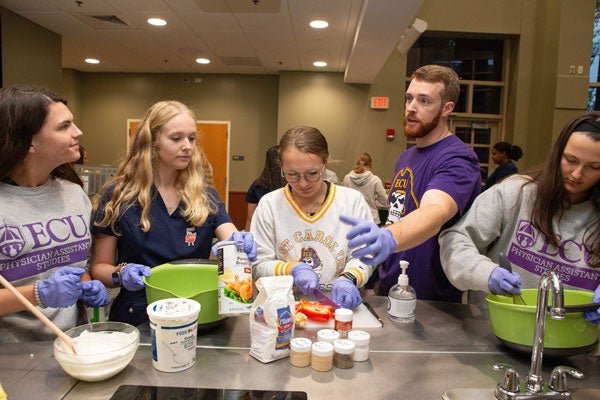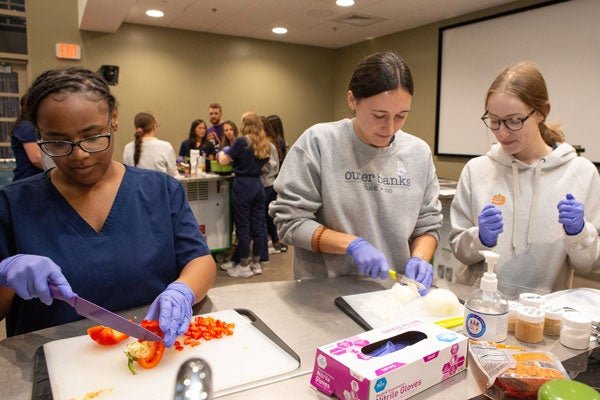Pilot program brings culinary medicine to PA students
East Carolina University’s Department of Nutrition Education has piloted a program to teach future health care providers the ins and outs of food, and how to prepare nutritious meals, as that they can incorporate nutritional medicine into their practices and pass on the knowledge of health-promoting foods to them. patients.

Farm2Clinic assistant director Brandon Stroud shares cooking tips with physician assistant students during a clinical culinary class.
Dr. Lauren Sastre, assistant professor of nutritional sciences in the College of Allied Health Sciences, says the culinary arts initiative is important because even health-educated students often don’t understand the macro- and micronutrients, and how how are they doing. affect life in general. Sastre said that perhaps most importantly, many people are hindered by not having the tools to budget for healthy foods and how to use basic cooking skills.
Sastre said that the idea of exposing health students to the concept of holistic medicine – combining culinary arts and nutrition science – has been carried over from the health conference. public beauty about 10 years ago, where he was introduced to this idea for the first time. which was included in the curriculum of a few medical schools across the country.
The promotion of health professionals related to nutritional medicine is not a new idea, but thinking of food as medicine has not been included in health care – yet. Another highlight is Jessica DeLuise, a physician’s assistant who promotes food as the key to health as The Wellness Kitchenista on TV and social media.
Sastre and his team have made significant progress in recent years with the Farm2Clinic project, which brings nutritional medicine concepts to communities that need to be encouraged to adopt healthy eating habits.
“One of the most important parts of our Farm2Clinic program is to help people realize that it’s not that hard to make healthy and delicious food,” said Sastre. “So, I did a deep dive into the literature, and it was only done with medical students. You don’t see it done with PA students or nurses. ”

Students assisting physicians with a plate of food they have cooked as part of a clinical culinary experience.
Finding access to physician assistant students was relatively easy, as it is part of the same college as the nutrition science department, and Sastre has a strong connection with the College. of Nursing, located next to the Health Sciences Campus.
During the summer Sastre met with a colleague in the physician assistant (PA) program to reinforce the nutrition training Sastre had been giving students for several years. Sastre offered an alternative – why not include a comprehensive literacy course in a limited amount of time, including financial planning and key nutritional skills as well as cooking skills?
“I want to make sure we’re giving them information that translates into patient care,” Sastre said. “We have so many nutritional problems in the United States, 90% of what we spend on health care is managing a chronic condition – everybody has it now. These diseases are not Chronic diseases such as diabetes and hypertension are driven by poor dietary habits, yet we do not have comprehensive nutrition training for our health providers.
Not everyone can afford to see a nutritionist, Sastre said, but they have access to primary care from a physician’s assistant or nurse practitioner. Helping shape how those primary care providers counsel their patients is a great step forward in dealing with chronic health conditions.
Bridging the Knowledge Gap
One of the cultural changes that Sastre has identified as contributing to the current state of health in North Carolina and across the US is the decline in home economics education in schools – a budget manager among a skill that most adults don’t have.
“We are decades away from people having no basic knowledge of food. We can have a fancy nutritional medicine class and teach fancy things, but if a person can’t make a plan of use of money to get healthy food into their homes, we don’t check the boxes,” said Sastre. “What we’ve done with this fleet is much broader.”
Kinston’s Raven Breinholt, a public health student and research assistant and coordinator of Farm2Clinic, who earned her Bachelor of Science degree in nutrition and dietetics from ECU in 2023, worked with PA students on the basic skills of to cook during the day of medical supply, leading his peers to prepare. cabbage and turkey casserole. The simple dish was an example of how a nutritious, balanced meal can be easy to make and easy on the wallet.

Students helping doctors cut vegetables to be used in meals as part of a culinary medicine class.
“When working with patients it’s important to understand the different health conditions of patients and how that affects their ability to cook healthy meals. It’s very difficult to buy fruits and vegetables,” Breinholt said, but can be done.
Couple the lack of kitchen skills with unaffordable food prices, and it’s no wonder that many people are turning to cheap, over-processed, unhealthy foods. , Breinholt said. He said the interdisciplinary approach is the best move for ECU’s nutrition science department and students and their peers in health, nursing and medicine.
“We need to work together as a team to ensure that every patient receives the best care possible, and we need to start building those relationships now, ” said Breinholt.
Kendra Brent, a second-year medical student from Bristol, Tennessee, says cooking is a big part of her life, but the demands of the PA program have taken her away from the kitchen more than she would like.
He knows that the rural parts of North Carolina and his home in Tennessee do not always have the best eating habits – that “we love all things fried” – but the opportunity to learn from Sastre and the students of his way of changing the attitude of patients. the food was stimulating.
“This is great because it gives me an idea of how I can teach my patients. It’s possible; it’s possible,” said Brent.
Brent says the focus on nutrition is a welcome respite from the disease-heavy focus of the PA program. Working with his nutrition peers, who are in a different program but focused on improving health in the area, helped Brent feel like they were all on the same team, working toward a common goal. one.
“It was great working with them. You are seeing a new side of medicine that I didn’t know existed. I didn’t know culinary medicine was a thing until this morning. It’s nice to know that they are resources out there,” Brent said.
Food is a central part of people’s emotions, a part of culture, and Sastre knows that making many changes to Americans’ food choices will be a challenge.
“To some extent, we have to go back and forth,” said Sastre, but he remains motivated to continue to fight for change alongside students who represent education across the spectrum of health.
Other Stories
#Pilot #program #brings #culinary #medicine #students